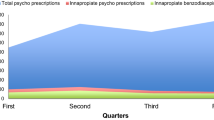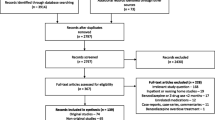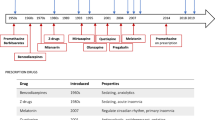Abstract
Background: The global use of benzodiazepines and cyclopyrrolones is generally high. The hypnotic and anxiolytic effects of these agents typically diminish after a period of weeks or months of continuous use. Patients may thus be caught in a trap where the usefulness of these substances is reduced and doses are consequentially escalated, and where a subsequent phased reduction in dose can be difficult. Although considerable resources have been expended on reducing the use of these agents, no unambiguous and effective method has been identified.
In Denmark, it is estimated that there are approximately 100 000 benzodiazepine-dependent patients, constituting approximately 2% of the general population. The prescription of dependency-producing drugs (including benzodiazepine/cyclopyrrolone agents) in Denmark is regulated according to Danish directive CIR nr 12, introduced on 13 January 2003, which aimed for restrictions in the prescribing of benzodiazepine and cyclopyrrolone drugs while setting revised guidelines for the re-evaluation of these agents. However, by 2004, the use of these drugs had decreased by only 1.7%, far from the official objective of a 50% reduction.
This article describes an effective strategy implemented in general practice in Denmark to reduce the use of benzodiazepine and cyclopyrrolone agents, while at the same time challenging practitioners’ ingrained habits and prejudices in this field.
Design: An intervention involving new regulations for the prescription of benzodiazepines and cyclopyrrolones was introduced to ten Danish medical practices, comprising 13 medical practitioners and a patient base of approximately 18 500 patients. The new intervention was essentially in accordance with the official Danish regulations, such that a prescription for benzodiazepines and cyclopyrrolones could only be issued for 1 month at a time, and only following consultation. Telephone prescriptions were eliminated. Use was monitored using the Danish registration system, Ordiprax, which monitors sales of prescription medicine. All users of benzodiazepines and cyclopyrrolones within the ten practices, with the exception of seriously psychiatrically and physically ill patients, were included.
Results: Fifteen months after the inception of the intervention, the use of cyclopyrrolones was reduced by 50.3%. Use of benzodiazepine-hypnotics was reduced by 46.5% and use of benzodiazepine-anxiolytics was reduced by 41.7%. The reorganisation of prescription patterns proved to be significantly easier than practitioners had expected. During the first 3 months, only 4.3 additional consultations per week per 1000 patients were required. Subsequently, this number fell to 2.1 additional consultations. The usual collaborative partners, such as psychiatrists, homecare services, hospitals and substance abuse units, were essentially not deployed. No serious side effects developed in patients in whom drug use was reduced.
Conclusion: The intervention was effective in reducing the use of benzodiazepine and cyclopyrrolone agents in general practices in a large municipality in Denmark. It is recommended that this intervention be introduced into the primary care sector, as it requires minimal effort on the part of the medical practitioner. The intervention is as simple as it is effective, and its implementation does not require any major level of supplementary training.




Similar content being viewed by others
References
Ashton H, Golding JF. Tranquillisers: prevalence, predictors and possible consequences: data from a large United Kingdom survey. Br J Addict 1989; 84: 541–6
Srisurapanont M, Critchley J, Garner P, et al. Interventions to reduce benzodiazepine prescribing (protocol). Cochrane Database Syst Rev 2006; (2): CD005172
Jørgensen VRK, Toft BS, Fogh MS. Reducing the use of benzodiazepines and cyclopyrrolones in clinical practices [in Danish]. Ugeskr Laeger 2006; 168: 1636–40
Jørgensen VRK, Toft BS, Fogh MS. Reducing the use of benzodiazepines and cyclopyrrolones in clinical practics. Pharm Pract 2006; 4(2): 74–8
Gyldmark M, Hansen EH. The social costs of dependency on psycho pharmaceutics [in Danish]. Lœgemiddelforskning 1997: 36–7
Chief Medical Officer’s update 37. Benzodiazepines warning: patient safety [online]. Available from URL: http://www.benzo.org.uk/cmo.htm [Accessed 2007 Sep 16]
Communication regarding the prescription of addictive drugs. Directive CIR 12 from 13/01/2003. Copenhagen; Danish National Board of Health, 2003
Danish Medicines Agency. The consumption of benzodiazepines and benzodiazepine related drugs [online]. Available from URL: http://www.dkma.dk/visUKLSArtikel.asp?artikelID=11644 [Accessed 2007 Sep 16]
Systematic review of the benzodiazepines. Guidelines for data sheets on diazepam, chlordiazepoxide, medazepam, clorazepate, lorazepam, oxazepam, temazepam, triazolam, nitrazepam, and flurazepam. Committee on the Review of Medicines. BMJ 1980; 280(6218): 910–2
Ashton CH. Benzodiazepines: how they work and how to withdraw. The Ashton manual [online]. Available from URL: http://www.benzo.org.uk/manual/index.htm [Accessed 2007 Sep 11]
Allain H, Bentue-Ferrer D, Polard E, et al. Postural instability and consequent falls and hip fractures associated with use of hypnotics in the elderly: a comparative review. Drugs Aging 2005; 22: 749–65
Wang PS, Bohn RL, Glynn RJ, et al. Zolpidem use and hip fractures in older people. J Am Geriatr Soc 2001; 49: 1685–90
Cumming R, Le Couteur DG. Benzodiazepines and risk of hip fractures in older people. CNS Drugs 2003; 17: 825–37
Ordiprax: a tool for doctors and regions. Fact sheet from the Danish Medicines Agency [online]. Available from URL: http://www.ordiprax.dk [Accessed 2007 Sep 7]
Mouland G. A letter to benzodiazepine users: an efficient way to reduce the prescription [in Norwegian]. Tidsskr Nor Laege-foren 1997; 117: 3097–100
Andreasen CM, Errebo-Knudsen L, Kristensen KA. Patient information might reduce the use of benzodiazepines in general practice [in Danish]. Ugeskr Laeger 1989; 151(45): 2968–70
Holden JD, Hughes IM, Tree A. Benzodiazepine prescribing and withdrawal for 3234 patients in 15 general practices. Fam Pract 1994; 11: 358–62
Ashton H. Benzodiazepine withdrawal: outcome in 50 patients. Br J Addiction 1987; 82: 665–71
Acknowledgements
The author is a part-time employee of the Medicine Team, Region Midtjylland, Holstebro, Denmark, and is primarily involved in the field of dependency-producing drugs. He has received honoraria from public funding for the further education of practitioners for lecturing on drug reduction in clinical practice, as well as funding within the constraints of the Danish Medicines Agency from the pharmaceutical industry for a single lecture on drug reduction in clinical practice.
Funding received from the Ministry for Interior Affairs and Health pool for studies and initiatives related to drug issues, including compliance, was used to assist in conducting the study and writing up the results.
Thanks are extended to practitioners in Lemvig for their cooperation, as well as their willingness to be the first to implement the new rules in a larger region.
Author information
Authors and Affiliations
Corresponding author
Rights and permissions
About this article
Cite this article
Jørgensen, V.R.K. An Approach to Reduce Benzodiazepine and Cyclopyrrolone Use in General Practice. CNS Drugs 21, 947–955 (2007). https://doi.org/10.2165/00023210-200721110-00006
Published:
Issue Date:
DOI: https://doi.org/10.2165/00023210-200721110-00006




